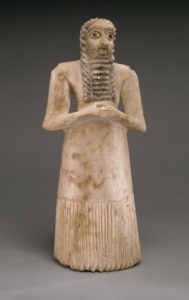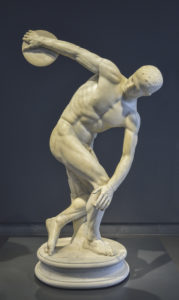During Ancient Greece art work defines humanism as man being the center of the deities. Although worshiping gods was still an important aspect of human beliefs, the belief that man was at the center of everything that happened around them became more practiced. In contrast, during Mesopotamian art they believe that gods where the reason for everything that happened around them, therefore men would worship gods the majority if the time and they would respect their divine presence. In Ancient Greece gods would be respected only for limited people. Men thought that gods were the same as them because they were able to have sexual intercourse with them. In both periods of time it is illustrated how art differs from each other, one worshipping gods and the other focusing on the beauty of men.
In the image below we can see the “Standing Man Worshipper” sculpture where it represents the idea that man could not possibly be worshipping gods all the time. Therefore they decide to create sculptures like the one below so that it represents an everlasting prayer. This is an example of Mesopotamian art,
‘
In the image below we can see a muscular man, the “The Discobolus of Myron” about to throw a disc across a big field, we could imagine. This is an example of Greek art where the work of art is more detail and naturalism is more present compared to the sculpture mentioned before. The life-like features such as toned muscles, long strong legs, and toned abdomen demonstrates that art focused on the beauty of men. The beauty of strong men who in this case play sports and the art work has captured a specific moment before he throws the disc. This specific work of art demonstrates that gods were no longer the center of their lives but man on their own had to be worshipped as well.


